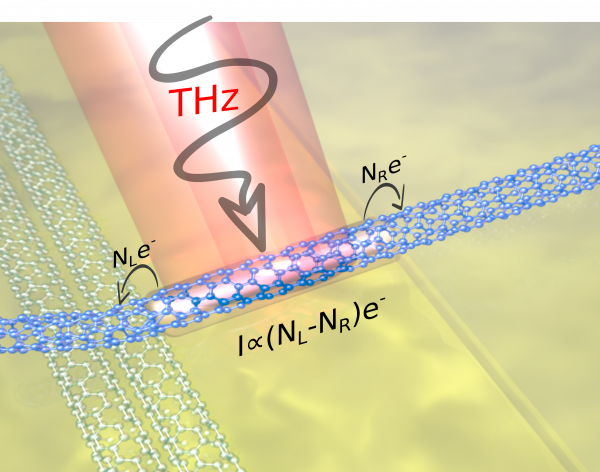Metallic carbon nanotube quantum dots with broken symmetries as a platform for tunable terahertz detection
Terahertz (THz) radiation is all around us. For example, this page emits blackbody radiation mainly in the THz region (broadly from 0.3 THz to 30 THz). Because terahertz radiation begins at a wavelength of around one millimeter and proceeds into shorter wavelengths, it is sometimes known as the submillimeter band, and its radiation as submillimeter waves, especially in astronomy.
This band of electromagnetic radiation can be regarded either as microwave radio waves or far-infrared. The technology for its generation and manipulation is in its infancy; that is why engineers talk about the THz gap (in this case, from 0.1 to 10 THz). One of the reasons is that THz radiation from traditional microwave sources is usually too weak to have any measurable impact on the properties of materials. The situation drastically changed at the beginning of the 2000s, when the technique of optical rectification with phase matching in crystals lacking inversion symmetry such as lithium niobate was developed. This technological breakthrough enabled the development of table-top sources of single-cycle THz pulses with field strengths comparable to the intrinsic field strength in a wide range of strongly correlated materials. Consequently, it became possible to modify their intrinsic fields to engineer new dynamic states of materials.
In condensed matter physics and in general, THz radiation is an efficient tool to investigate a multitude of low-energy excitations existing in the THz region. Important examples are resonances of phonons and plasmons (collective lattice and electron vibrations, respectively), spins, intersubband transitions (subbands are electronic energy bands formed in quantum wells, in which the electrons are confined in two directions), excitons (bound electron-hole pairs), macro-molecular vibrations and molecular rotations.
THz radiation can penetrate most dielectric materials non-invasively, opening the way for numerous possible applications in the fields of medicine, security, chemical spectroscopy, and data transmission, notably in the framework of the future 6G cellular network. This is why photodetection and emission in the THz regime have recently attracted much attention from fundamental and applied research communities.
The authors have proposed a theoretical scheme for a fully tunable THz detector based on carbon nanotubes. Specifically, using numerical simulations and scanning tunneling spectroscopy, Buch et al. show that breaking simultaneously various symmetries in metallic nanotube quantum dots of arbitrary chirality strongly relaxes the selection rules in the electric dipole approximation and removes energy degeneracies. This leads to a richer set of allowed optical transitions spanning frequencies from 1 THz to several tens of THz for a ∼10 nm quantum dot. The researcher team proposed a terahertz detector device based on a metallic single-walled carbon nanotube quantum dot defined by artificial defects based on these findings. The operating regimes range from a high-resolution gate-tunable THz sensor to a broadband THz detector, depending on its length and contacts transparency. Their calculations indicate that the device is mainly unaffected by temperatures up to 100 K, making carbon nanotube quantum dots with broken symmetries a promising platform to design tunable terahertz detectors that could operate at liquid nitrogen temperatures.

Figure: Proposed device to be used as either a high-resolution gate-tunable terahertz sensor or a broadband terahertz detector.



